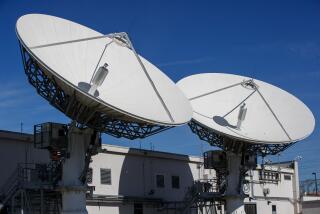Hughes’ DirecTv Already a Rival to Cable : Technology: But the direct-to-home satellite service is still far from the subscriber level it needs to break even.
- Share via
Five months after its national rollout, GM Hughes Electronics Corp.’s direct-to-home satellite television service is off to a quick start and, despite some drawbacks, is already a bona fide rival to cable TV in American households.
The service, El Segundo-based DirecTv, beams at least 150 channels of programs via two satellites to consumers who have paid about $700 for a special receiver and pizza-size antenna dish. Once installed, the service costs about $30 a month--more if one buys movies on demand or special sports packages.
DirecTv, available from 11,000 retail outlets, has more than 400,000 subscribers and is on track to reach 1.5 million by year-end, said DirecTv President Eddy Hartenstein. Between 2,500 and 3,000 customers sign up daily, he said.
Though still not making money, the service is growing “faster than we expected,” said C. Michael Armstrong, Hartenstein’s boss and chairman of GM Hughes Electronics.
In the glow of that early success, GMHE on Thursday announced a new venture to expand the service to Mexico, Central and South America and the Caribbean, an area with 77 million households with TV.
That project will be run by another GMHE division, Hughes Communications, along with TV concerns in Mexico, Brazil and Venezuela that will help provide programs in Spanish and Portuguese.
GMHE isn’t stopping there. “We’re already in discussions with Japan, Asia and Europe” about similar services, Armstrong said.
In the U.S. market, some analysts said, DirecTv--having used its satellites to completely bypass the cable industry’s expensive wiring networks and support staffs--is an undeniable hit.
With digital signals that provide exceptionally clear images, DirecTv “is not something you can throw darts at anymore; it has established itself,” said Jimmy Schaeffler, an analyst at Paul Kagan Associates, a media research firm in Carmel.
DirecTv’s sales have already dwarfed first-year sales of other recent consumer electronics innovations, such as the videocassette recorder, big-screen TV and the audio compact disc, he said. At an industry seminar last month, Schaeffler said, “we had representatives of the cable industry who openly admitted the concern they have for this as a competitor.”
Cable readily concedes DirecTv’s splash.
“We view them as real, significant and very well-financed competition,” said Rich D’Amato, spokesman for the National Cable Television Assn. in Washington.
“We also believe we’re prepared to meet that competition” with improved service, more program choices and competitive prices, D’Amato said. Cable is also expected to offer improved direct-to-home satellite service of its own in coming years.
DirecTv also has certain handicaps, at least for some viewers. It does not carry local TV broadcasts--that requires an extra, old-fashioned antenna. Also, DirecTv’s dish must face in the general direction of Texas, and it can’t face major obstructions that block the satellite signal.
Further, watching two different channels of DirecTv on two TV sets in the same house requires two receivers. Each receiver costs about $650.
And GMHE officials remain cautious when describing DirecTv’s outlook. They noted that the service is still far from the 3-million-subscriber level where they’ve calculated DirecTv will break even. That plateau should be reached late next year, they said.
That means GMHE is still years from recouping its $750-million investment in the project, never mind a return on that investment.
“We don’t fool ourselves about the initial success,” which to a large degree reflects strong sales to video connoisseurs and sports fans, Armstrong said. “I’m sure that sometime in the second half of this year, we’re going to have to work even harder to create demand for DirecTv rather than just filling the supply,” he said.
He’ll get help shortly. In exchange for developing DirecTv’s receiver-antenna, France’s Thomson got exclusive rights to produce the first million units under the RCA brand name. That arrangement is likely to be fulfilled in May or June, when Sony Corp. will also start making the equipment. Even more manufacturers will jump into the market later this decade.
The result: Just as prices of VCRs plunged in the 1980s after production increased, prices of DirecTv equipment are expected to drop $100 or more a year, which should expand the system’s appeal.
And price is a key factor in DirecTv’s future, because providers of the service hope to reach not only households in rural areas where TV choices are limited, but also urban areas where cable is already available and doesn’t require DirecTv’s upfront costs.
RCA-Thomson is one of three partners that helped GMHE get DirecTv off the ground with major investments. The others are Hubbard Broadcasting Inc. and the National Rural Telecommunications Cooperative.
Hartenstein said DirecTv still expects to reach 10 million subscribers by the turn of the century. If so, GMHE in less than a decade will have formed an enterprise with annual revenue exceeding $3 billion, moving the company further away from its once-heavy reliance on Pentagon contracts.
GMHE, with $14 billion in sales last year, is the General Motors Corp. subsidiary that includes defense giant Hughes Aircraft Co. and auto parts maker Delco Electronics. Under Armstrong, GMHE has aggressively entered new commercial markets to offset the decline in defense spending.
But his bet on DirecTv won’t pay off just yet. Salomon Bros. analyst George D. Shapiro has estimated that until DirecTv breaks even, the service will lose about $100 million this year and $25 million in 1996.
More to Read
The biggest entertainment stories
Get our big stories about Hollywood, film, television, music, arts, culture and more right in your inbox as soon as they publish.
You may occasionally receive promotional content from the Los Angeles Times.











